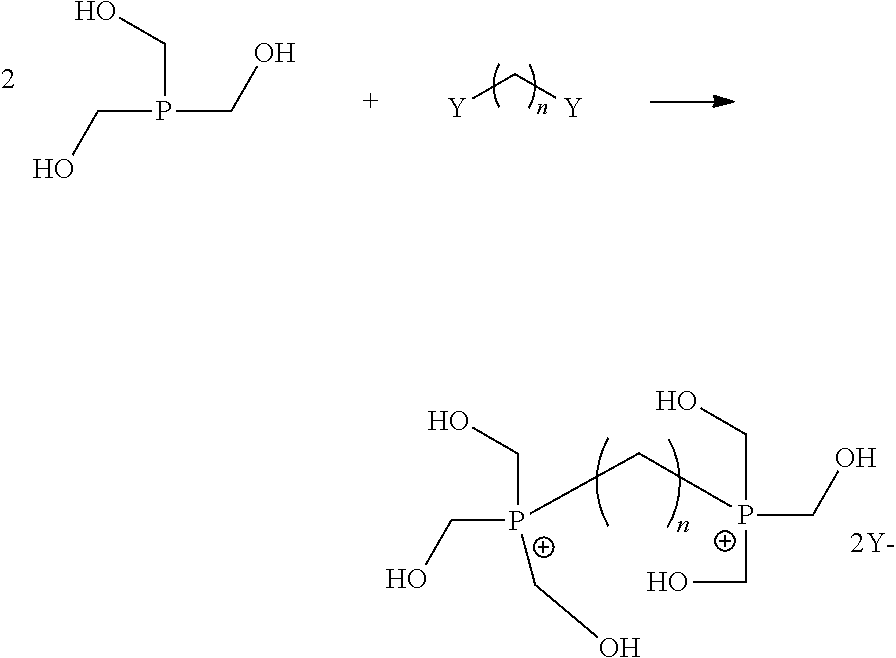Organophosphorus derivatives and use thereof as uncoupling agents
a technology of organic phosphorus and uncoupling agent, which is applied in the direction of biocide, plant growth regulator, water treatment parameter control, etc., can solve the problems of reducing the biomass generation by inhibiting energy production, increasing the proportion of carbon oxidized, and the uncoupling agent reducing the energetic yield of the combustion of carbon, etc., to achieve less rapid degradability of bioactive substances
- Summary
- Abstract
- Description
- Claims
- Application Information
AI Technical Summary
Benefits of technology
Problems solved by technology
Method used
Image
Examples
example 1
Step a) Synthesis of a Trishydroxymethyl Phosphine Solution
[0057]In a perfectly stirred reactor equipped for vacuum distillation, inertized beforehand under nitrogen, is loaded:
[0058]a solution titrating 80% THPC (tetrakis(hydromethyl)phosphonium chloride) and containing 150 g of THPC (0.63 mol);
[0059]the mixture is cooled to 5-15° C.;
[0060]385 g of an 8% soda solution are poured within 3 hours and with control of the temperature at 5-15° C.;
[0061]at the end of the pouring, the reaction mixture is maintained at 10° C. for 12 hours;
[0062]the formaldehyde formed is removed by distillation of a water / formaldehyde mixture at a temperature of 15-30° C. and at a pressure <10 mbars;
[0063]970 g of ethanol are added and distillation is performed under the same conditions in order to use up the formaldehyde;
[0064]precipitation of NaCl is observed and after distillation the reaction mass is analyzed:
[0065]Analyses: 93.5% of THP / 3% THPO / 3.5% THPC
example 2
Steps b) and c): Synthesis of Phosphonium (Formula (1) with n=8, m=0 or 1)
[0066]The reaction mass prepared in Example 1 is introduced into a perfectly stirred reactor equipped for vacuum distillation, inertized beforehand.
[0067]While controlling the temperature at 45-55° C., 111.8 g of 1,8-di-iodoctane are poured within 30 minutes.
[0068]The reaction medium is biphasic and precipitation of salts is observed (NaI / NaCl).
[0069]After being maintained at 50° C. for 50 hours, the reaction medium is filtered and the obtained product is a pale yellow limpid solution from which a mass of 665 g is extracted having the following NMR analysis (nuclear magnetic resonance):[0070]31P NMR analysis[0071]3% THPO[0072]3% THP[0073]14% THPC[0074]78% of phosphonium derivatives according to a following molar composition of the di-phosphonium and tri-phosphonium:
[0075]
[0076]n=8
[0077]87%
[0078]
[0079]n=8
[0080]13%
example 3
Step a) Synthesis of a Trishydroxymethyl Phosphine Solution:
[0081]In a perfectly stirred reactor, equipped for vacuum distillation, inertized beforehand under nitrogen, a solution titrating 80% THPC (tetrakis(hydromethyl)phosphonium chloride) with 100 g of THPC (0.42 mol) and water (50 g) is loaded;
[0082]The mixture is cooled to 5-15° C.;
[0083]228 g of the 8% soda NaOH solution are poured within 3 hours and with control of the temperature at 5-15° C.;
[0084]At the end of the pouring, 10° C. is maintained for 12 hours;
[0085]The formaldehyde formed is removed by distillation of a water / formaldehyde mixture at a temperature of 15-30° C. and at a pressure of less than 10 mbars;
[0086]786 g of ethanol are added and the reaction mixture is distilled under the same conditions in order to use up the formaldehyde;
[0087]Precipitation of NaCl is observed.
PUM
| Property | Measurement | Unit |
|---|---|---|
| Mass | aaaaa | aaaaa |
| Mass | aaaaa | aaaaa |
| Mass | aaaaa | aaaaa |
Abstract
Description
Claims
Application Information
 Login to View More
Login to View More - R&D
- Intellectual Property
- Life Sciences
- Materials
- Tech Scout
- Unparalleled Data Quality
- Higher Quality Content
- 60% Fewer Hallucinations
Browse by: Latest US Patents, China's latest patents, Technical Efficacy Thesaurus, Application Domain, Technology Topic, Popular Technical Reports.
© 2025 PatSnap. All rights reserved.Legal|Privacy policy|Modern Slavery Act Transparency Statement|Sitemap|About US| Contact US: help@patsnap.com



